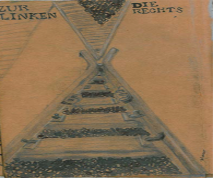An event as horrific in its impact and magnitude as the Holocaust, called for proper documentation in the years that followed it. The most valued documentation developed in the form of literary responses that majorly comprised of the first-hand accounts and narratives of the Holocaust survivors. These were published in the weekly newspapers that circulated in the displaced persons’ camps. These not only served as a means to vent out their emotions but also as a way of re-connecting to their kin if they had survived. During the initial years after the catastrophe, the Holocaust historians, as well as survivors, have remained divided in their opinion with regard to the literary response to the Holocaust and consequently the genre of Holocaust literature. Moreover, there also existed the ethical dilemma of whether or not an event such as the Holocaust should be represented in any form or genre.
In the Encyclopedia of Holocaust Literature published in 2002, the editors David Patterson, Alan L. Berger, and Sarita Cargas explore the literature that developed in response to the Holocaust. The fact that the seemingly contradicted term ‘Holocaust literature’ exists is because the “soul is there” (xiii). They state that the Holocaust literature holds a unique and distinguished place as it transcends the event of the death into a return to life, and in the process, the readers become a witness. They conclude,
The literary response to the Holocaust is a human being’s endeavor to restore to life a relationship to humanity that harbors the affirmation of life. It entails a movement of memory—for memory is its defining feature— by which a soul undertakes a movement of return (xiv).
In a more recent work, Literature of The Holocaust (2004) edited by Harold Bloom, the Holocaust historian, Alvin Rosenfeld, in his chapter, ‘The Problematics of Holocaust Literature’, acknowledging the significance of Holocaust literature discusses the ethical problematics of the unresolved query about the tension between ‘claims of silence’ and ‘claims of word’ (41). He approaches this question through the writings of Elie Wiesel and Primo Levi and expresses that although the writers mentioned the brutalities and horrors of the concentration camps, there existed a latent struggle to express the emotions clearly. He thus states that the Holocaust literature transcends beyond the scope of being classified as ‘topical literature’ (21), as it demands a certain amount of sensibility and responsibility on the reader’s part. Rosenfeld further opines that the Holocaust literature is a ‘chronicle of the human spirit’s most turbulent strivings with an immense historical and metaphysical weight’ (22). He also highlights the role of the reader, as it is only through the reader’s imagination and understanding of the text that inexplicable and unwritten horrors are rendered intelligible. The fact that Holocaust literature apart from the Jewish languages (Yiddish and Hebrew) is written in every European language, classifies it as an ‘international literature’ (25). In the words of David Patterson, Alan L. Berger, and Sarita Cargas,
Holocaust literature is a testimony to the absolute dearness of every human being. It teems with a sense of urgency which disturbs our comfort and complacency to put to us the question put to the first human being: Where are you? Thus it transforms death into life by transforming its reader into a witness (Encyclopedia of Holocaust Literature, xiv).
Artistic Representations of the Holocaust
A creative domain through which Holocaust memories can be mediated is visual art. The artists depicting the Holocaust in their paintings explore the maxim of pictures speaking a thousand words. One of the earliest artworks is by Morris Kestelman entitled Lama Sabachthani (Oh God, why have you forsaken me?) which depicts a group of Jewish people mourning over a pile of unburied corpses. The artist Edgar Ainsworth visited the Bergen Belsen concentration camp after liberation and recorded the scene in his drawing, Belsen: April 1945 in which he sketched various aspects of the camp. The best-known Holocaust artwork is Charlotte Salomon’s play Life? Or Theater? composed of seven hundred sixty-nine paintings. The artworks form a major part of exhibitions in the Holocaust museums particularly the Yad Vashem, Jerusalem. The Holocaust is also depicted in the artworks produced by artists born after 1945. The most well known example is of post Holocaust artwork is by Anselm Kiefer. His painting Margarethe (1981) is inspired by Paul Celan’s “Todesfuge” and Goethe’s Faust and depicts the golden hair of Margarete in the form yellow straws. Another painting Sternenfall (Falling Stars) created in 1998 depicts a sky with celestial bodies that are numbered, alluding to the tattooed numbers, both of which are alphanumeric. The Auschwitz Album published in 1981 and Auschwitz: A History in Photographs published in 1993 remain the best-known photographic record books of the largest death camp of Auschwitz.
More recent works include artworks by Morris Kagan, a second-generation survivor who shares his father’s artwork on social media. His father, Henry Kagan was a woodcarver, a skill that helped him survive the concentration camps as he used to carve sculptors on the order of camp commanders. Caroline Slifkin, an artist as well as a Holocaust educator specialises in teaching about the Holocaust through Holocaust art. She has created a Holocaust Arts Project called “Fragments of Family” in 2016. The project is included in the curriculum of various schools in order to develop critical thinking and visual literacy. In her sessions, Caroline invites the students to discuss historical artwork and to create their own works in response. Students view the art as a form of documentation, witness, spiritual resistance, and as evidence from the victim’s perspective. Through the use of visual images, students are able to develop visual literacy to add to their skills of critical thinking in order to understand, recognize and evaluate arts as a means of expression. The students are thus able to investigate human behaviour, and come to appreciate that silence and indifference to suffering of others however unintentional can lead to events that allow for legalized discrimination, prejudice, hatred, and ultimately mass murder. Caroline believes that learning about the Holocaust can evoke powerful emotions and using the creative arts can help students to express their thoughts, ideas, and responses in an appropriate and creative way.


Daniela Mansur, the creative art director at Tributart and the author of Art Therapy Journal: Holocaust Without Words through a chronological artwork narrates a wordless story of the Holocaust.


Daniela offers a blended approach as she commemorates she not only pays tribute to the Holocaust victims and survivors through her art but also believes in telling the story of the Holocaust through her art in order to teach the future generations.
Conclusion
The artistic works of the Holocaust portray the intricate human reactions to exploitation, and to the annihilation of one’s life and culture. The artistic works created by survivors or victims as well as third-party witnesses depict a kaleidoscope of themes that are self-reflective and thus deepen our understanding of the Holocaust. The two forms that have dominated the literary corpus of the Holocaust literature are the memoirs and diaries written by survivors that are believed to be the most authentic accounts of the Holocaust experience. Apart from these, over the years other forms such as poetry, theatre, music, dance and storytelling have emerged. The memoirs and diaries together provided first hand accounts of the horrors of the catastrophe, thereby informing the readers what living during the Holocaust was. There is also a proliferation of Holocaust fiction, which propels the readers to imaginatively enter the realms of experiences of the narrator. The artistic works not only serve as a means of commemorating the Holocaust but are also a powerful medium for educators to teach about the Holocaust.
The post The Altering Landscapes: Mediation of Holocaust Memories through Art appeared first on Strife.






















